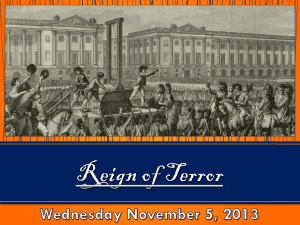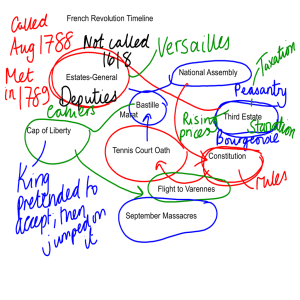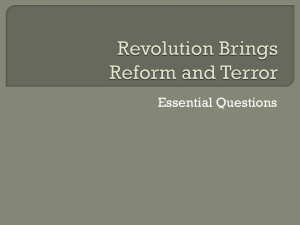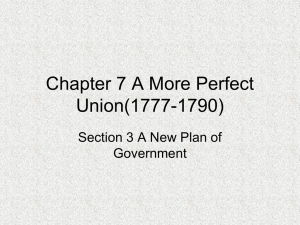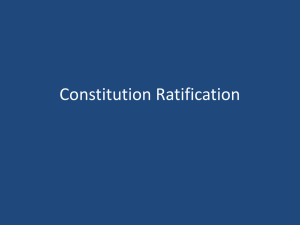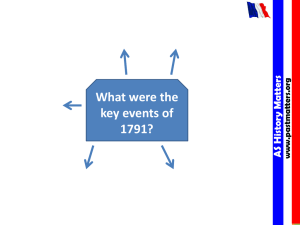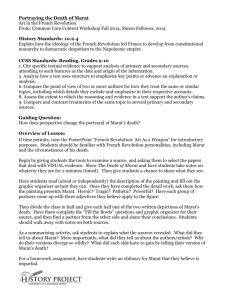France - Area of Study 2
advertisement
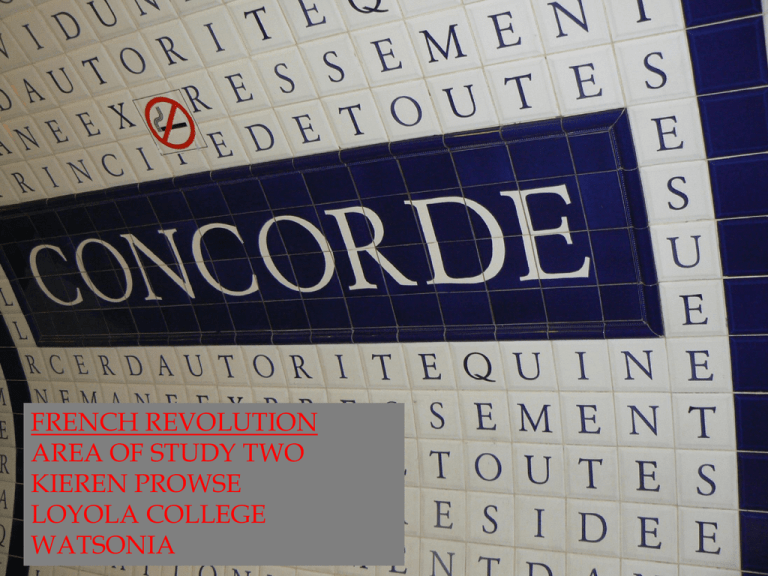
Area of Study Two Kieren Prowse St Columba’s College, Essendon FRENCH REVOLUTION AREA OF STUDY TWO KIEREN PROWSE LOYOLA COLLEGE WATSONIA To gain an understanding of: What is Area of Study Two French Revolution? How can I learn all this information? So Much! What can I do to succeed in the exam? Top 5 tips for success! August Decrees – Constitution of Year III approved and dissolution of Convention. 5 August 1789 – 22 August 1795 (5 Fructidor Year III) and 26 October 1795. The contribution of individuals to the new society The cause of difficulty or crises for the new regime The response to these crises from leaders, groups, governments or parties The compromise of revolutionary ideals Change and continuities from the old regime Gather knowledge and evidence of the crises faced in the new order Analyse evidence of the responses to these crises by the participants in the new order Evaluate the degree to which the revolution brought about change from the old regime Consider (understand) a range of historian’s opinions Knowledge: know two-three things about as many topics as you can. Remember key dates with accuracy Have a bank of ‘small’ key quotes to support your comments in your writing Understand the various ‘trains of thought’ regarding historians interpretations of the revolution. Be able to use these in your writing to support your answers. Writing: Write clearly Be concise Write continuously Use Quotes August Decrees National Constituent Assembly Declaration of Rights of Man and Citizen Women’s march to Versailles Reorganisation of society Festival of Federation 14 July 1790 Le Chapelier Law 14 June 1791 Constitution of the Clergy and Clerical Oath Flight to Varennes Champ de Mars Massacre International War – Declaration of Pillnitz Constitution of 1791 Girondins Jacobins Cordeliers The centre of Plain Feuillants Monarchists Montagnards San Culottes The Federes Journee 20th June 1792 La Patrie en Danger Brunswick Manifesto Journee 10 August 1792 September Massacres National Convention Trial of Louis XVI Execution of Louis XVI Civil War Vendee Rebellion/Vendee Terror The Terror Committee of General Security Committee of Public Safety Robespierre Flight of Dumouriez Trial of Marat Expulsion of the Girondins Assassination of Marat Federalist Revolt June 1793 Enrages Law of Suspects Execution of Marie Antoinette De Christianisation Execution of the Girondins Law of Frimaire Hebertists Danton and the Indulgents Cult of Supreme Being Law of 22 Prairial Fall of Robespierre Thermidorian reaction Dismantling of Jacobinism White Terror Vendee and Royalist invasion Louis Charles (Louis XVII) Church in new revolutionary state Economy under Thermidor Journee of 12 Germinal Journee of 1 Prairial Constitution of Year III Council of Elders Council of Five Hundred The Directory 1789: Year of Insurrection 1790: Year of the Church 1791: Year of Varennes 1792: Year of International War 1793: Year of the Terror 1794: Year of Executions 1795: Year of Constitution I CVITEC 5-11 August August Decrees Women’s March to Versailles October 5-6 Women’s March to Versailles October 5-6 12 July Civil Constitution of the Clergy 27 November Clerical Oath 27 November Clerical Oath http://commons.wikimedia.org/w/index.php?title=File:Carte_des_pr%C3%AAtres_asserment%C3%A9s_en_France_en_1791.svg&page=1 Accessed : October 1, 2012. 20-25 June Royal Family’s flight to Varennes 17 July Champ de Mars Massacre 14 September King finally accepts Constitution 20-25 June Royal Family’s flight to Varennes 17 July Champ de Mars Massacre 20 April France declare war on Austria 25 July Brunswick Manifesto 10 August Second invasion of the Tuileries King deposed 25 July Brunswick Manifesto 10 August Second invasion of the Tuileries King deposed 21 January Louis executed March-January 1794 Uprising in the Vendee 6 April Creation of the Committee of Public Safety 13 July Assassination of Marat 21 January Louis executed 13 July Assassination of Marat 5 April Danton and his followers executed 8 June Festival of the Supreme Being 10 June Law of 22 Prairial 27-28 July (9-10 Thermidor) Meeting of the Convention and arrest and execution of Robespierre and his followers. 8 June Festival of the Supreme Being 27-28 July (9-10 Thermidor) Meeting of the Convention and arrest and execution of Robespierre and his followers. 21 February Freedom of worship restored 1 April (12 Germinal) Sans Cullotes riot but suppressed 20 May (1 Prairial) Sections of Paris riot but suppressed 26 June Royalist invasion 22 August Constitution of Year III approved 26 October National Convention dissolved. 20 May (1 Prairial) Sections of Paris riot but suppressed General information: Question Booklet and Answer Booklet separate. Use Blue or Black pen 15 minutes reading time 2 Hours writing time You choose to write for which Revolution for which section. Ensure this is clearly marked. All four Revolutions will be in your question booklet. 1. Use quotes in your responses. 2. Make the quotes shorter. A few words. 3. Impress your examiner by utilising the work of various historians in your responses. Chapter 20 Analysing the French Revolution by Adcock is a must read. 4. Utilise your reading time in the exam to have all your planning done. 5. Maintain a strong structure in your writing. Fill in the bones of your piece with some quality detail you have remembered! prowsek@loyola.vic.edu.au Proper preparation prevents poor performance….. These materials are to be used for the purpose of individual study only. Some materials may be subject to copyright under the Copyright Act 1968. All reasonable attempts have been made to trace copyright holders for permission to use materials but the presenter invites anyone who believes they have copyright over items to contact him if they have any concerns.
